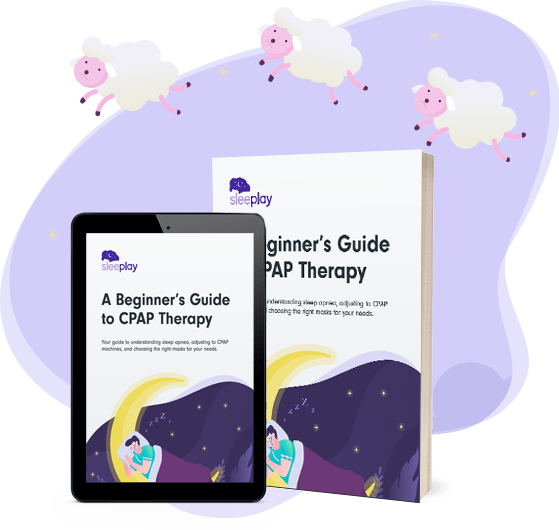An Introductory Guide to OSA (Obstructive Sleep Apnea)
Beyond the immediate grogginess, inadequate rest can increase the risk of health issues like cardiovascular diseases and weakened immunity. At the same time, emotional well-being suffers, leading to irritability and heightened stress levels.
A leading cause of poor sleep quality is obstructive sleep apnea. Sleep apnea is a sleep disorder that causes your breathing to stop multiple times during the night, getting in the way of a restful sleep.
The most common type of sleep apnea is known as obstructive sleep apnea.
Keep reading to learn what obstructive sleep apnea is, how to recognize it, and what treatment options exist to improve it.
What Is Obstructive Sleep Apnea?
Obstructive sleep apnea (OSA), also known as obstructive sleep apnea-hypopnea, is a medical condition characterized by recurrent episodes of upper airway collapse during sleep. This leads to decreased blood oxygen levels and triggers arousal, a reflex that wakes you up just enough so you can breathe again.
In people with obstructive sleep apnea, the muscles that support the soft palate, the tongue and the soft tissue at the back of the throat relax too much, which leads to upper airway collapse. The narrowed airway doesn’t allow proper airflow during inspiration, which means there’s not enough oxygen getting into the airway and then into the bloodstream.
The decrease in blood oxygen levels activates a reflex in the brain stem that briefly wakes the person up in order to reopen the airway. This disruption can repeat itself from five to 30 times per hour during the night. Although these arousals are brief and may not be remembered, they prevent the individual from reaching the rapid-eye-movement sleep (REM) or deep phase of sleep, which causes the person to feel sleepy during the waking hours.

How Do I Know if I Have Obstructive Sleep Apnea?
Obstructive sleep apnea symptoms are usually present for years before the person realizes there’s an issue. Some of the most common symptoms are:
-
●Insomnia: Frequent sleep disruptions, especially in cases when the person is fully awakened by the arousals.
-
●Excessive daytime sleepiness: Sleepiness during daytime activities, especially if they are quiet ones, such as reading.
-
●Loud snoring: Usually noticed by a family member or partner. It can be preceded by a brief moment without breathing.
-
●Irritability and difficulty concentrating: Lack of sleep can profoundly affect the ability to focus.
-
●Dry mouth or sore throat: People who snore or have nasal congestion tend to breathe through their mouth and develop dryness.
-
●Being awakened by a choking sensation: Following a breathing pause.
-
●Morning headaches and confusion
-
●Decreased libido
- ●Nocturia: The need to get up multiple times during the night to urinate.

Consequences of Untreated Obstructive Sleep Apnea
Since most people do not realize they have a sleep disorder when they experience some of the symptoms listed above, it is fairly common for OSA to remain untreated. Untreated OSA can have severe consequences on a person’s health, such as:
-
●Heart problems: Disruptions in air pressure, along with shifts in the oxygen and carbon dioxide balance, coupled with factors like body weight and inflammation, have been associated with the development of hypertension, heart failure, arrhythmias, and other heart diseases. If left unaddressed, these conditions may progress and ultimately lead to a heart attack.
-
●Type 2 diabetes: The lack of proper sleep has been associated with the development of insulin resistance and type 2 diabetes.
-
●Digestive issues: The stress response can divert blood flow and nutrient supply away from the digestive system, causing digestive issues such as gastroesophageal reflux disease.
-
●Mental health problems: People living with OSA have an increased risk of developing anxiety, post-traumatic stress disorder, and depression. This is because their brain activity remains heightened throughout the night, disrupting the restorative quality of their sleep and causing diminished oxygen levels.
- ●Increased risk of accidents: The difficulty concentrating and confusion associated with OSA makes it more likely to cause a traffic accident, as well as other types of accidents. This means it might not be safe to drive or use heavy machinery if you have OSA.
If you notice any of these symptoms, seek medical advice andif you suspect you might have OSA, we can help you find a sleep specialist.
How to Diagnose Obstructive Sleep Apnea
A healthcare provider must get all of your personal medical information, as well as perform a physical examination and calculate your apnea-hypopnea index (AHI) in order to make a diagnosis.
AHI is a measure used in sleep medicine to quantify the severity of sleep apnea by counting the number of apneas (complete breathing cessations) and hypopneas (partial breathing reductions) per hour of sleep.
Then, they will request a sleep study that can be done at home or in a practitioner’s office.
These are the two main types of sleep studies:
-
●Home sleep apnea testing: This type of test allows you to perform a sleep study from the comfort of your home using a portable sleep monitor, such as the WatchPAT One. A home sleep test can be accurate if the person has moderate to severe OSA, but it may not be the best option for people with other sleep-related disorders or medical conditions.
- ●Contact one of our sleep specialists to discuss if a home sleep test is right for you.. Overnight sleep study, polysomnogram or polysomnography: In this case, you’ll need to sleep in a sleep center, a medical facility equipped to monitor a person’s sleep. Some things that are monitored in these tests are brain waves, heart rate, blood oxygen levels, and breathing rate.
How Was OSA Discovered?
Sleep apnea has been around for many years, and there is evidence that people have been suffering from sleep-related disorders for centuries. However, this condition was not studied much back then, as doctors and researchers did not have the tools we do today.
It wasn’t until the XIX century that this condition got a name: “Pickwickian syndrome.” The doctors back then chose this name after Charles Dickens’ novel The Pickwick Papers, in which there is an overweight character that showcases the same symptoms that most people with sleep apnea do today.
Later on, Pickwickian syndrome was classified as a sleep-related illness only associated with obesity called obesity-hypoventilation syndrome since obesity may cause pharyngeal collapse and make it harder for the thorax to expand during inspiration. Sleep apnea didn’t become a separate term until 1965.
Medicine has come a long way since then. Nowadays, there are plenty of studies focused on understanding this condition, and it is easy to diagnose it from home using the WatchPAT One.
In 1981, the first CPAP (Continuous Positive Airway Pressure) device was created, which gave individuals a way to treat this illness without surgery. The sleek and efficient machines we use today are a far cry from those devices; however, they still use the same basic principle that the first-ever CPAP device used. We use this device today, and it’s a very effective form of therapy for obstructive sleep apnea.
Risk Factors of Obstructive Sleep Apnea
Any person can develop obstructive sleep apnea. However, some characteristics can make this sleep disorder more likely to happen in certain demographics, including:
-
●People older than 60 years: The risk of developing OSA is two to three times higher in older adults than in people between 30 and 60 years old.
-
●Males: Men have two to three times more chances to have OSA than women. However, after menopause, women have almost the same risk.
-
●Obesity or excess weight: Most people with OSA have excess weight, but it is not indispensable. Additionally, some conditions related to obesity (such as polycystic ovarian syndrome and hypothyroidism) have also been connected to OSA.
-
●Physical features: Some anatomical variations are associated with a narrowed airway, such as a lower jaw (a jaw that is small or positioned farther back), enlarged tongue, large tonsils or adenoids, a neck circumference larger than 17 inches (or 43.18 cm), and excess fat surrounding the throat.
-
●Nasal congestion: People with a constant stuffy nose are twice as likely to develop OSA.
-
●Smoking: People who smoke cigarettes have a higher risk of having OSA than those who don’t.
-
●Alcohol and sedatives use: These substances can disrupt the way the brain controls the breathing rate and also contribute to the excessive relaxation of the muscles in the back of the throat.
- ●Family history: People within a family usually share physical features and lifestyles, which could explain why direct relatives of people with OSA have a higher risk of developing it.
Treatment Options for Obstructive Sleep Apnea
The Treatment Options for OSA has many approaches and alternatives, which is why it should be tailored to each person’s needs. Therefore, a healthcare provider should help you decide the best treatment method for you. We can classify the treatment of OSA in these categories:
Lifestyle Changes
Some nonmedical measures can improve obstructive sleep apnea to a point when it does not happen anymore or at least becomes less severe. For example, for people with excess weight or obesity, an important aspect of this type of approach would, of course, be weight loss.
On the other hand, treating underlying conditions can also improve the symptoms. For example, using nasal sprays for nasal congestion can improve the airflow through the nostrils and the rest of the upper airway. Optimizing the treatment for heart disease can also help.
Finally, avoiding alcohol and some medications, such as benzodiazepines (commonly used for anxiety) and opioids (painkillers), can also be beneficial.
Positional Therapy
Facing the ceiling while sleeping makes the soft tissues of the back of the throat press against the windpipe, increasing the risk of experiencing sleep apnea episodes. Because of this, it is recommended that people who have OSA sleep on their side. There are special support pillows that make this position more comfortable.
Positive Airway Pressure (PAP) Therapy
Positive airway pressure or PAP therapy involves using a device that sends air pressure through the upper airway, keeping it open and thus allowing the air to flow properly.
These devices are bedside machines that have a hose attached to a mask that covers your nose and mouth (or only your nose), and they pump air through the whole system. There are many different types available, and they can function in three different ways:
- ●Continuous positive airway pressure (CPAP): These devices pump air at a determined pressure consistently during both inspiration and expiration. CPAP therapy is usually used to treat people with OSA. Although CPAP is only one type of PAP therapy, the term CPAP therapy is usually used indistinctly to refer to all types of PAP therapy.
- ●Bilevel positive airway pressure (BiPAP): In this case, inhalation and exhalation pressures are different. It is used in people who require different levels of pressure to inhale and exhale, providing more personalized breathing support compared to continuous positive airway pressure.
- ●Auto-titrating positive airway pressure (APAP): This kind of PAP therapy allows air pressure to change in response to some signals from the body of the user, such as snoring.
Exploring Positive Airway Pressure (PAP) therapy, CPAP (Continuous Positive Airway Pressure) is commonly used as a universal term. However, it's crucial to understand that CPAP is just one aspect of the broader PAP landscape, representing diverse approaches to address sleep apnea and related issues.
Oral Appliances or Mouthpieces
These are removable devices that are fitted by a dentist. They work by holding the tongue and the lower jaw in a position that allows air to flow properly through the upper airway. These are usually helpful for people with mild OSA.
Nerve Stimulators
Nerve stimulators are devices that can be implanted under the skin of the chest and connect to an electrode attached to the hypoglossal nerve, which controls the movement of the tongue. By turning the device on, it will send signals for the nerve to keep the tongue slightly forward so it does not collapse the upper airway.
Surgery
For those who have a specific physical feature that is causing or worsening OSA, surgery can be a helpful option. Some surgeries used are:
-
●Somnoplasty: This surgical intervention reduces the soft tissues around the upper segment of the windpipe using radiofrequency.
-
●Uvulopalatopharyngoplasty: In this case, the uvula and soft tissue from the soft palate are removed to widen the space between the mouth and the pharynx.
-
●Tonsillectomy and adenoidectomy: These surgeries remove the tonsils and adenoids to widen the space between the nose, mouth, and throat.
-
●Nasal surgery: People with a deviated nasal septum, for example, could have a septoplasty, which straightens the septum and eases the airflow.
- ●Jaw surgery: A small change in the position of the jaw can help widen the upper airway, especially for people with micrognathia.
Living with OSA: What Does a Diagnosis Mean For You?
Obstructive sleep apnea is a common and serious medical condition that needs to be addressed as soon as symptoms are noticed in order to improve your quality of life. Those who exhibit symptoms must be evaluated by a healthcare provider, who will order sleep tests to verify the diagnosis and decide which type of treatment is the best option.
This sleep disorder might seem intimidating at first. However, following up with a professional will help you figure out how to deal with OSA in the most efficient way possible. There has been significant progress in comprehending this condition, and there are many treatment options to fit each individual’s needs.
A Few Final Words
Obstructive sleep apnea can be a daunting illness. However, with the treatments that exist today, you’ll be able to deal with it in the best way for you. The technology will only get better as time goes on, so don’t be disheartened by your diagnosis. We hope that this article has helped you to learn more about this illness.
If you want to learn more about sleep apnea, check out our blog. At Sleeplay, you can find all the information you need about sleep apnea, as well as the best CPAP machines and supplies on the market!
Join the conversation!, login and comment.

Get your guide to understanding sleep apnea, adjusting to CPAP machines, and choosing the right masks for your needs.









